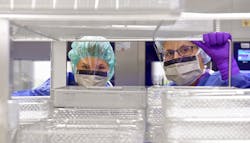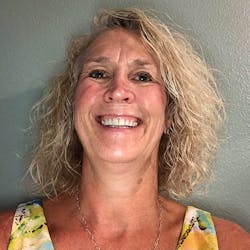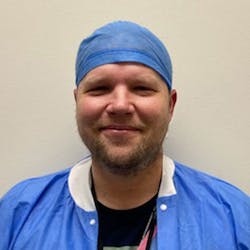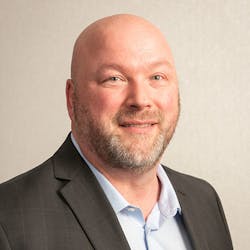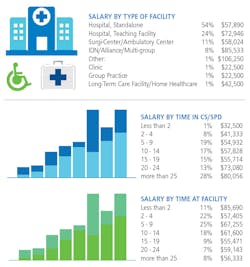Although the COVID-19 pandemic has forced elective surgery cancellations and delays, job security in the Central Service/Sterile Processing & Distribution (CS/SPD) department has remained high and the average annual salary is up 5%, according to the results of the 2021 Healthcare Purchasing News CS/SPD Salary Survey.
Salary increases were reported across most CS/SPD positions, with the biggest gains seen for:
• Educators: $76,944 in 2021, up 21% from $63,846 in 2020
• CS/SPD Directors: $105,656 in 2021, up 8% from $97,630 in 2020
• CS/SPD Supervisors: $57,778 in 2021, up 5% from $54,783 in 2020
The annual average salaries for Surgical Instrument Technicians, Lead CS/SPD Technicians, CS/SPD Technician/Coordinators and CS/SPD Managers remained close to the same as last year, with only nominal increases and decreases. A new category for this year was Quality Assurance Technician, with an average annual salary of $37,500 in 2021.
The majority of respondents said their salaries had grown over the previous year (64%), and 22% expect bonuses in 2021, which is up from 10% in 2020.
There were too few respondents in the OR Liaison and Certified Medical Device Reprocessing Technician categories to accurately report on 2021 salaries in these positions.
While 26% of CS/SPD professionals surveyed said they were laid off, furloughed or their hours were reduced in 2020 because of the pandemic, the vast majority (90%) reported feeling very or somewhat secure in their jobs.
Significant gender pay gap
According to the results of this year’s survey, male CS/SPD professionals earn on average 25% more than their female counterparts. The average annual salary for males surveyed was $75,156, compared with $59,728 for females; a $15,428 pay gap. One reason for this discrepancy could be the much higher percentage of female survey respondents, which was 75% of total respondents compared with males at 23% (2% of respondents chose not to disclose their gender.)
Education and location matter
The higher the level of education attained, the higher the salary in the CS/SPD profession. Those with post-graduate degrees reported the highest pay ($93,088), followed by Bachelor’s degrees ($80,341), Associate degrees ($64,622) and high school diplomas ($49,244).
CS/SPD professionals working in integrated delivery networks (IDNs) take home the largest paychecks, with an average annual salary of $85,533, followed by those working in teaching hospitals with a reported average salary of $72,946 in 2021. The next highest in pay were from those working at surgicenters/ambulatory centers at $58,024, followed by standalone hospitals at $57,890, and long-term care facilities/home healthcare at $42,500.
Urban healthcare facilities were at the top of the pay scale, with an average CS/SPD salary of $71,287, suburban sites fell in the middle at $63,645 in pay annually, and rural sites came in last at $51,837.
The average salary soared in the Pacific region of the U.S. to $86,521 in 2021, a 35% increase from $63,871 in 2020. The next highest region was the Mountain region at $69,806, a 16% jump from $60,274 in 2020.
Whereas the Northeastern states are typically at the top of the list when it comes to compensation, they fell to third place this year, with an average annual salary of $63,743, down from $64,202 in 2020. Next came the Southeastern states at $57,596 in 2021, up from $52,059 in 2020. The Central region had the most significant pay drop, with an average salary of $53,539 in 2021, down from $60,100 in 2020, an 11% decrease.
Certification matters
Certification remains steady as employer compensation for it grows. The percentage of CS/SPD professionals who are already certificated remained the same compared with last year, at 89%, while those in the process of getting certified fell to 4% in 2021 from 6% in 2020. The number of individuals considering certification doubled; 4% in 2021 up from 2% in 2020.
On a positive note, the reported number of employers providing higher levels of compensation to those who earn certified education units/points more than doubled compared with last year, at 22% in 2021, up from 10% in 2020. When asked if certification was a requirement for their position, the response was the same as last year, at 62%, with 6% of employers considering this requirement.
The majority of those surveyed hold certification from the International Association of Healthcare Central Service Materiel Management (IAHCSMM) at 69%, followed by the Certification Board for Sterile Processing & Distribution (CBSPD) at 28%. Association for the Advancement of Medical Instrumentation (AAMI) certification was also high on the list at 23%.
On average, more CS/SPD professionals are pursuing continuing education as well. Those participating in 10 or more courses and lessons annually rose to 89% in 2021 up from 79% in 2020, with 35% of those participating in 20 or more courses, up from 34% in 2020.
“My ideology as a manager is that our department is only as strong as its weakest link,” Rohmann said. “I am a major proponent of cross training as many staff members as possible. Should a need arise, there is always someone available to fill the spot. Growing leaders and increasing staff morale and confidence are all results of expanding the experiences that techs face. Peer-to-peer accountability increases. All of this impacts the patient in a positive way.”
Shifting roles, responsibilities
The roles and responsibilities of U.S. CS/SPD professionals over the past year were largely influenced by the COVID-19 pandemic with its direct impact on elective surgery volumes. In some cases, the pandemic presented opportunities for CS/SPD teams to demonstrate their value beyond their departments, while in other cases, teams looked internally on how they could improve operations during downtime.
Extending out
Many hospitals redeployed CS/SPD staff resources from surgical instrument reprocessing to other areas to support COVID-19 patient and clinical staff demands. In other healthcare facilities, CS/SPD leaders leveraged the surgery slowdown as an opportunity for their teams to strengthen the effectiveness and safety of their departments’ processes.
When asked how they were affected by the COVID-19 pandemic, 64% of survey respondents said they helped reprocess personal protective equipment (PPE), which has been in short supply and high demand, 30% have spent time cleaning and disinfecting durable medical equipment, and 19% have been cleaning and restocking code carts.
“In a short period, the world went from a standard of professionals required to use PPE for work-related reasons to an emergency need by the public for everyone’s safety,” said Rohmann. “To this date, we are still experiencing shortages due to backorders. Our world was caught unprepared for something of this magnitude and continues to feel the ramifications.”
Rohmann notes how the reprocessing of N-95 masks during the pandemic, while necessary to combat shortages of this critical PPE, has been “a monumental change” to processes.
“This is the first instance of reprocessing a single use item as ‘acceptable’ that I have experienced,” he stated. “This has forced us as an SPD profession to disregard one of the oldest rules in our business.”
Among those surveyed, 52% said they have supported additional departments during the pandemic, with 39% saying their CS/SPDs reassigned staff members to help clean in other hospital areas.
Many believe the work of CS/SPD professionals to support additional areas of their hospitals during the COVID-19 pandemic has served to increase recognition for the profession and its importance to patient care and safety.
Turning within
CS/SPD professionals also reported focusing internally on their department’s operations during the pandemic, with 42% saying their teams reorganized and evaluated instrument usage and storage, 34% updated instructions for use (IFU) and other sterile processing policies, and 13% turned their attention to staff certification. More than half (54%) said their departments implemented new processes or procedures in light of the pandemic, with an additional 4% currently in the process or planning stages.
While the COVID-19 pandemic has forced significant change in the CS/SPD, there are many elements of the profession that have remained the same. As Rohmann explains, CS/SPD professionals have always faced the threat of exposure to dangerous viruses and other pathogens; therefore, universal precautions will remain a key consideration during the pandemic and beyond.
“Those two words are our mantra in SSPD for self-preservation,” he noted. “We deal with far worse contaminants (than SARS-CoV-2) on a daily basis. This is something that we must assume will be part of every shift we punch the clock for. It is not a requirement for SPD to be notified when instrumentation has been exposed to HIV, Hepatitis C and B to name a few. Decontam will always be one of the most dangerous places to work in a hospital.”
As always, “quality and commitment to patient safety through the delivery of clean and sterile surgical instrumentation” remains at the forefront of CS/SPD operations and has only been heightened during the pandemic, according to Lane.
“The resilience and integrity of the SPD/CSSD team never ceases to amaze me,” she observed. “While the staff is always committed to doing their best at all costs, they truly seem to shine even brighter when faced with adversity. During this pandemic, the SPD/CSSD has been faced with many hurdles some of which were sterilizing single-use face masks due to shortages of PPE and working less hours in some instances due to the downturn in surgical volumes; however, the ‘can do’ attitude of the staff continued to shine.”
With regard to reporting structure, the results were similar to last year, with the following functions reporting directly to the CS/SPD head in their facility: Sterile processing (97%), decontamination (92%), case carts (58%), medical equipment cleaning/disinfection (44%) and GI/endoscopy (35%).
Unfortunately, not all CS/SPD professionals have weathered the pandemic unscathed from an employment perspective with 32% of those surveyed saying their organizations furloughed CS/SPD employees during the pandemic, and 4% reporting department closures.
Workflow, technology trends
“We have more voice and decision-making opportunities than ever before, as we have more tools at our fingertips to do what is necessary to keep our patients safe,” Thurmond told HPN. “That is obvious with the number of vendors with products and services to support Sterile Processing; each understands the importance of the role we play, and through product development and educational offerings, they are helping us be the best we can be.”
This year’s survey found:
• Track-and-trace systems usage is up: The majority of those surveyed say their facilities use such a system (62%), up slightly from last year (57%), with 6% currently in the process or planning stage of implementing a system.
• Continued emphasis on emerging disease safety: Again this year about half of survey respondents (49%) said they have a safety training program in place for handling instruments for patients with suspected emerging diseases, while 4% are in the planning stages.
• Decreased adoption of sterile processing workflow management systems: There was a drop in those reporting use of workflow management systems in their facilities, with 46% stating “yes,” compared with 52% in 2020.
• New measures for managing reprocessing-related outbreaks hold steady: As with last year, 45% of survey respondents reported that their facilities had put new measures in place.
• CS/SPD sticking to IFU methodologies: There was a large drop in respondents who said their facilities have changed their IFU methodology, at 8% in 2021, down from 22% in 2020.
Looking ahead
CS/SPD professionals offered their thoughts on the state of the profession today and what the field needs to gain greater recognition and increased compensation moving forward. Here are their responses:
Lane: “There is a need for greater appreciation and a clear understanding of the value of the SPD/CSSD profession, along with, mandatory certification and colleges with Sterile Processing programs. The lack of appreciation and recognition of the positions within the field as a professional career has hampered the profession in many ways and continues to do so. On the other hand, as the focus is shifting on the department as it relates to The Joint Commission findings and other regulatory bodies, I believe we will begin to receive more recognition and increased compensation and gain traction as healthcare professionals.”
Rohmann: “We must receive support. SPD continues to be the forgotten realm of the hospital. Until executives take an invested interest and the realization of our importance is achieved, we will continue to be over-looked. We have voices, we can be heard. The roadblock is that those that will actively listen are rare. Surgeries, and in turn, hospitals as a whole, cannot serve our patients without us. And if it weren’t for us, holding other departments to safety standards, the patient’s experience will be far worse. Compensation doesn’t stand a chance without that acknowledgement.”
Taylor: “Many people did not know what our job is (prior to the pandemic), and some didn’t know where we were located but now it seems we get a lot of ‘Thank yous’ for a job well done. I know our hospital staff is very grateful that we could help in such an uncertain time and I know our processing staff better understands how our job reaches beyond the care of our patients to physicians, co-workers, clinic staff and really everyone who needed to protect themselves from this pandemic. I’m proud to be on the team that worked together to provide safety and protection to so many.”
Thurmond: “Sterile Processing continues to grow as a field of work, and it is gaining more attention. As more information is spread about our profession (the growth opportunities and the potential to help others), we are being looked at more as patient advocates and safety monitors. Sterile Processing is being brought into meetings that they never attended before. Healthcare leadership is looking to Sterile Processing as the professionals to guide them—as opposed to decisions being made and then those trickle down to Sterile Processing. Sterile Processing continues to grow, and each day, Sterile Processing professionals are starting to feel that recognition. There is still a lot of work to do, but I feel it is definitely moving in a strong upward direction.”
About the Author
Kara Nadeau
Senior Contributing Editor
Kara Nadeau is Sterile Processing Editor for Healthcare Purchasing News.
